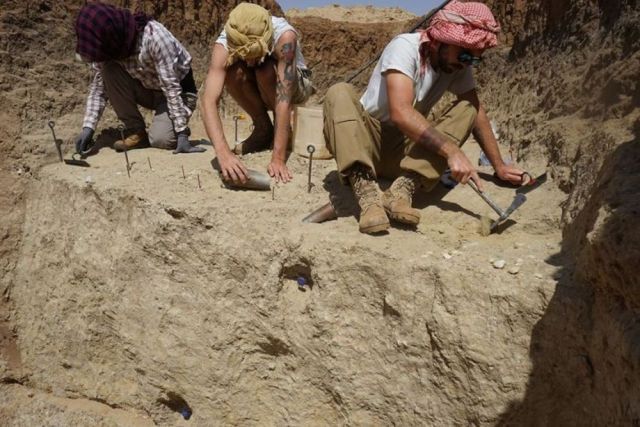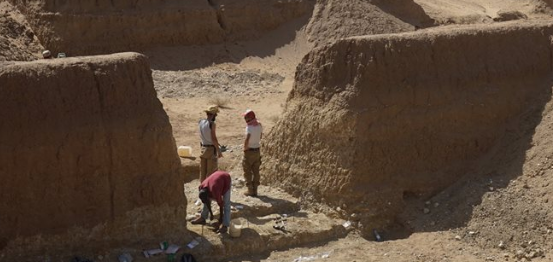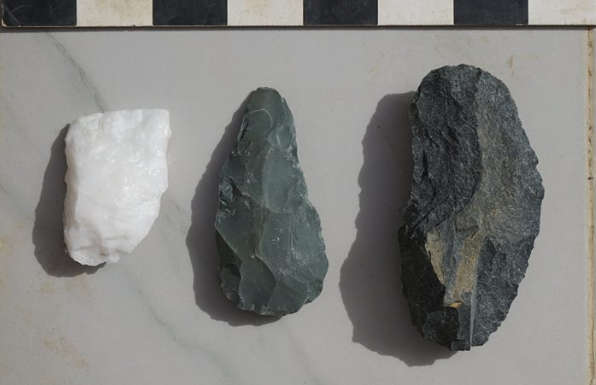by N.Morgan

During excavations in Eastern Sudan, the scientists from the Wrocław University’s Institute of Archeology found remnants of the humanoids’ presence which tell the untold story of the different phases of human species migration from half a million years ago. Instytut Archeologii Uniwersytetu Wrocławskiego/Facebook
A group of Polish archeologists have uncovered sensational proof that Homo Erectus, the ancestor of today’s humans, spread around the globe using previously undiscovered migration routes.
During excavations in Eastern Sudan, the scientists from the Wrocław University’s Institute of Archeology found remnants of the humanoids’ presence which tell the untold story of the different phases of human species migration from half a million years ago.

Discoveries in the Eastern Desert also confirm the long coexistence of Homo erectus with Homo sapiens in Africa: it is a period of at least 100,000 years, falling between 300,000 and 200,000 years ago. Both species lived there simultaneously. Instytut Archeologii Uniwersytetu Wrocławskiego/Facebook
The Polish archeologists, together with colleagues from Germany, Saudi Arabia, South Korea, and the United States decided to conduct their research north of the area, which is usually perceived as the cradle of humanity (along the Great Rift Valley, from Mozambique to the Red Sea) – the Eastern Desert in Sudan.
Enticed by the news, that gold miners in the area were uncovering prehistoric tools, the scientist not only confirmed this information but came across a lot more.

Enticed by the news, that gold miners in the area were uncovering prehistoric tools, the scientist not only confirmed this information but came across a lot more. Instytut Archeologii Uniwersytetu Wrocławskiego/Facebook
.png)
On March 6th, the archeologists summarized their project on the Institute of Archeology’s Facebook: “We just finished the last season of excavations in Sudan, which are carried out by our Institute in collaboration with Museum of Archaeology in Gdansk and Neelian University in Khartoum.
“This international project entitled ‘Homo erectus on the path to Eurasia…’ is focused on remains of Pleistocene settlement in the Eastern Desert. During this season we excavated four sites which yielded many finds.
“The oldest artifacts, which we found at archaeological site EDAR 7, are dated to 0,5 Ma [500 thousand years ago] and related to early middle Pleistocene Acheulean culture. This is the oldest known archaeological site in NE Africa.”

Homo Erectus migrations from Africa. PAP Infographics/PAP
What they found was that Homo Erectus traveled outside of Africa not only along the Nile river but also through what is now a desert which used to be a humid area with plants and rivers leading to the Red Sea.
Discoveries in the Eastern Desert also confirm the long coexistence of Homo erectus with Homo sapiens in Africa: it is a period of at least 100,000 years, falling between 300,000 and 200,000 years ago. Both species lived there simultaneously, although one gave birth to the other.
 The archeologists, led by Wrocław University’s Prof. Mirosław Masojć (pictured), discovered “… an assemblage of artifacts containing, among others, choppers and chopping tools, bifacial tools (hand axes and cleavers) and big flake tools. ”Instytut Archeologii Uniwersytetu Wrocławskiego
The archeologists, led by Wrocław University’s Prof. Mirosław Masojć (pictured), discovered “… an assemblage of artifacts containing, among others, choppers and chopping tools, bifacial tools (hand axes and cleavers) and big flake tools. ”Instytut Archeologii Uniwersytetu Wrocławskiego
The archeologists, led by Wrocław University’s Prof. Mirosław Masojć reveal they discovered “… an assemblage of artifacts containing, among others, choppers and chopping tools, bifacial tools (hand axes and cleavers) and big flake tools.
“Younger finds from the Middle Stone Age, which were manufactured using the Levallois method, can be linked to the settlement of this region by anatomically modern humans (Homo sapiens).
“Every day, we covered 90 kilometers in the desert from our base in Atbara to the sites. In the afternoons, after finishing field work, we devoted ourselves to analyses and recording of our artifacts. Some of the tools were chosen to be transported to Poland, which will allow us to conduct microscopic use-wear analyses.”
We have an affiliate program designed for content creators and Affiliate marketers, who would like to sell this product, please click here for affiliate program details. Our affiliate program is designed to help you monetize your screen time.

Reference:
No comments:
Post a Comment